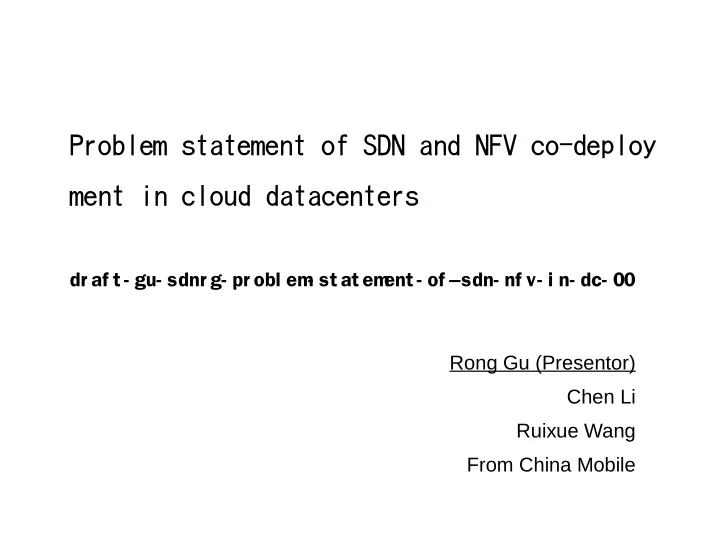

Problem statement of SDN and NFV co-deploy ment in cloud datacenters dr af t - gu- sdnr g- pr obl em - st at em ent - of –sdn- nf v- i n- dc- 00 Rong Gu (Presentor) Chen Li Ruixue Wang From China Mobile
Introduction • SDN and NFV technology co-deployed in public and private cloud DCs • Resolution test conducted aiming at the c o-deployment of SDN and NFV • Key problems to be working on
SDN-NFV usecase in cloud datacenters • Service application: Service requirement • Orchestrator: Orchestration • SDN controller: In charge of SDN data path and network • SFC controller: In central control of sfc • NFV manager: NFV lifecycle management • Network elements: Resource instances
Resolution test of SDN-NFV in cloud dc ——Test topology Internet Users Vrouter 、 Network 、 Security Overlay group Openst ack Floating IP / NAT SDN GW SDN GW syst em VLB CMNET Router VLB LB/FW/VPN service provided VFW VFW VPN VPN GW Underla GW Stress test Core SW y ToR Reliability and stability SDN cont r ol l er test / For w ar di ng Functionality and VSW VSW VSW VSW …… performance test devi ces Computing Security test node SW of Reliability and stability management test NFV Functionality and performance test VNFM Management Controllers Openstack traffic (master and standby) Service Security test traffic According to the test, SDN and NFV technology has been mature already for the commercial • deployment in operators’ network. • Performances of SDN controllers, forwarding devices have been improved with function of NFV included. There are some key problems remained. •
Resolution test of SDN-NFV in cloud dc ——Test cases For w ar di ng NFV Syst em Syst em Cont r ol l er devi ces ( vLB / vFW / VPN) Firewall Load balance and reliability Router and network OAM ACL Health check functionality of multi-controllers Speed of the flow table Master and Security group Firewall HA Stability Load balance forwarded and built standby of FW Load balancer Capacity of flow table in Floating IP Performance of vsw Throughput Session sticky functionality controller Maximum of vsw supported by New connection Load balancer HA N:1 NAT Multi-VIP controller maximum Security of South-bound Bandwidth limitation Co-connection Performance of of floating IP and IPSec functionality Interface maximum unique vlb NAT Security monitoring Number of vfw Number of vlb Bandwidth limitation IPSec HA in one server in one server of VM Secur i t y Traffic statistics Performance of SSL functionality SSL performance of VM unique vfw Performance of the Gateway Traffic Mirroring V-motion of VM Account security Security group Metadata function Authority security stress test Router and Network IP protocol security stress test Password security Log security
Problems and aspects to be considered —— Interface standardization • The interface of OpenStack is incomplete. – Physical servers are out of the scope of openstack. Neutron API has not been incomplete when considering some services such a – s traffic re-direction and service orchestration of service chain. – The plugins of LBaaS, FWaaS and some others are limited into one vendors. • With the help of SDN application, the extend restful API is necessary. Anyw ay, we hope openstack can include all the APIs. SDN APP SDN APP Application Application Neutron API Restful Neutron API API Openstack Openstack Orchestration Orchestration plugin plugin SDN Controller Controller SDN Controller Controller Openflow/XMPP/… Openflow/XMPP/…
Problems and aspects to be considered —— Network architecture and virtualized platform • SDN, NFV and openstack are all included in the DC, while co-operation of orchestration, SDN controller and SFC controller are not quite clear. ● The architecture of VNF from multi-vendors are not supported without integration. ● SDN and openstack has been researched deeply while NFV and openstack hasn’t. NFV function has been limited. • The virtualized platform KVM has been widely used while other platforms such as Xen and VMWARE ESXI need to be further researched on.
Problems and aspects to be considered —— HA, benchmark and practice experience • Telecom Systems requires 99.999% reliability, while virtualization technology brings extra challenges for high availability in NFV ● Divide high availability problem in NFV scenarios into three layers: hardware layer, NFV platform layer, and service layer. ● Each layer should work together to provide overall high availability ● Common API should be defined for NFV platforms to provide carrier grade high availability feature for VNF services. • Standardized benchmark on SDN and NFV with different methods of encapsulation, different realization mechanism of SDN controller and etc. • Practical practice experience such as network architecture selected and different deployments is eager to be shared.
Conclusion • SDN and NFV technology has been planned to be co-de ployed in the cloud datacenters. Through the resolution t est, we have found out that key problems on network arc hitecture, virtualized platform, standard interfaces, high a vailability and practice guidance exist. • Any comments and advices are welcomed.
Thank you gurong_cmcc@outlook.com gurong@chinamobile.com
Recommend
More recommend